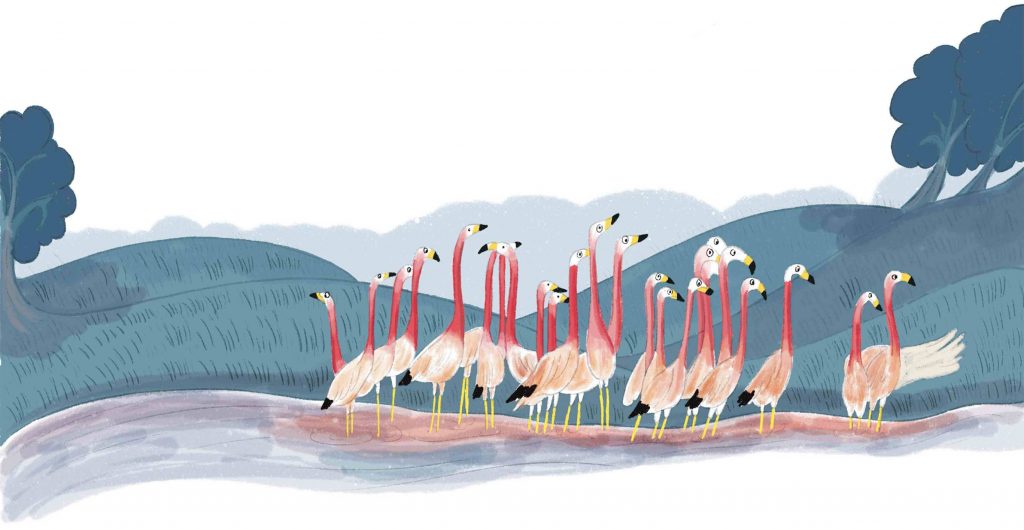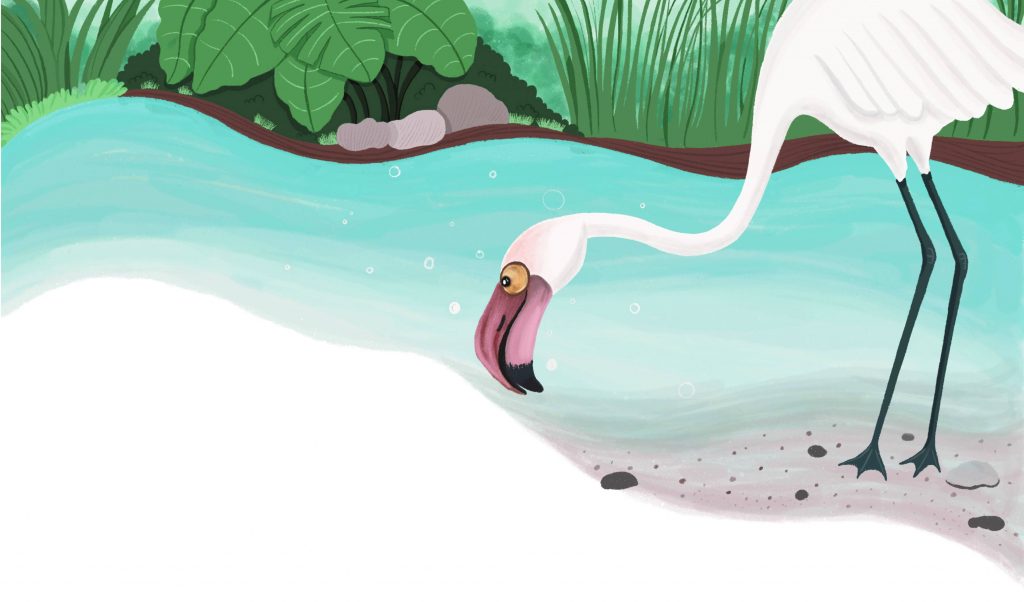Thanks to their bright, cheerful plumage, hefty, crooked bill, and spindly legs—one often held aloft in that iconic balanced position—flamingos are instantly recognisable to people around the world.
Although we often refer to them as ‘pink flamingos’, there are actually six different species of flamingos, all in varying hues of light red. These include: the American (also called Caribbean, Cuban, or rosy), greater, Chilean, lesser, Andean, and puna (or James) flamingo. The greater flamingo is the largest, while, unsurprisingly, the lesser is the smallest—and because the two live together in many parts of Africa, we are able to observe this startling size difference in the wild.
Around the world, in different cultures spanning thousands of years, flamingos have been famous for their dazzling feathers. The Mesopotamian people named them issur nuri or ‘the bird of light’, while ancient Arabic speakers referred to them as nuham or ‘the flaming one’. There are even some theories that the flamingos’ fiery plumage and their habit of mysteriously disappearing and then unexpectedly reappearing days, or even weeks, later, may have inspired the myth of the phoenix.
Fossils of the early ancestors of flamingos have been collected from five continents. Some of the specimens date back to the Cretaceous era—approximately 120 million years ago. Samples from two million years ago—not nearly as long ago but still fairly old—reveal flamingos that look surprisingly similar to those we see today, meaning they must have lived in similar environments and behaved in similar ways all this time.
While we often picture them standing still by the water’s edge or striding through the shallows, flamingos are actually good swimmers. In fact, they are more closely related to swimming birds like grebes than they are to wading birds like herons. It has taken scientists decades to figure this out because flamingos are notoriously challenging to study. They live in remote places that often have no direct access by road. The sites have very saline water, and the salt crystals can coat the terrain, making it jagged and hard to walk across. Many flamingo researchers from the 19th and early 20th centuries reported wearing holes in their boots trying to get close enough to the birds to study them properly.

Living in such inhospitable places has been beneficial to flamingos because it has kept them safe for millions of years. Few other creatures can survive in such extremes. For flamingos living in Africa, it is often the case that the only fresh water available to drink is as hot as a cup of coffee. Their cousins in the South American plateaus, however, may need to break free from ice each morning, after the water has frozen around their legs while they sleep.
Flamingos can get chilly even at warmer sites, and researchers think that their notable one-legged stance is a method of ‘thermoregulation’; adjusting their body temperature—by tucking one leg up close, they can retain body heat in the same way we do when crossing our arms.
In lakes, whether warm or cool, flamingos feed on tiny creatures like brine shrimp and blue-green bacteria (cyanobacteria), which they filter from the water with the help of little combshaped structures in their bills called ‘lamellae’. It takes a lot of effort to find enough of these microscopic animals to keep their bellies full, so the majority of their time is spent feeding. It is worth the effort, though—not only does it keep them from feeling hungry, but these little organisms contain the pigments that give flamingos their bright, beautiful colours. (Humans can experience a similar effect from eating too many carrots!).

Another benefit of living in remote wetlands is that these sites offer a great place for flamingos to nest. The birds make cone-shaped mounds of mud by scooping it up with their bills, until the nests are high enough for them to sit on comfortably. This requires a decent amount of mud, which means that breeding typically only happens after a good bout of rain.
When the conditions seem right, flamingos signal their readiness by engaging in elaborate marching and dancing manoeuvres. At sites like Lake Natron in Tanzania, millions of flamingos gather to nest, and dances may involve many hundreds of birds at a time.
These large population numbers sound promising, but flamingos are fairly vulnerable overall. For instance, there are thought to be only 34,000 Andean flamingos, and of the three million or so lesser flamingos—the most abundant species—90 percent nest at a single site – which leaves them very exposed should anything happen to the environment. Wetland habitats are threatened around the world because of human activity, and wild flamingos are known to be quite sensitive to disturbances, such as car and air traffic. This may prevent them from breeding, which is especially problematic since they typically don’t attempt their first nest until they are at least ten years old; although, fortunately, they can live several decades more, if ‘Mr James’, a 60-year-old resident at the Slimbridge facility in the United Kingdom, is any indication.
In the past, humans have used flamingos for some pretty strange purposes. In South America, for example, flamingo products were used to treat lung disorders, while ancient Mediterranean sailors were thought to have traded flamingo feathers for Cornish tin. Today, however, the main ‘use’ of flamingos is as a study species in zoos and conservation facilities, where scientists are working hard to learn how best to keep animals safe, healthy, and happy in captivity, and how to maintain captive populations that can be used to repopulate wild habitats should there ever be a need.
This is beneficial both to the birds and to humans, since flamingos thrive in zoos and are also one of the most popular attractions worldwide, drawing visitors whose entry fees can be used to support conservation efforts for flamingos and other wildlife. Of course, it is also possible to see flamingos in the wild, especially in tourist destinations like The Bahamas, Kenya, and India.
If you can’t make it to one of these locations, though, don’t worry. You can add some pink flamingo cheer to your garden with one of Don Featherstone’s famous plastic flamingos (invented in 1957 and still on sale today), check out one of the fabulous books on flamingos recommended below, or spend some time on one of the flamingo activities included in this issue!

QUIZ : How much do you know about the flamingo?
- What is the flamingo’s closest relative?
- How many species of flamingos are there in the world?
- Which mythical creature has been associated with flamingos?
- What did the Phoenicians (ancient sailors) get from the Cornish
in exchange for flamingo feathers? - What shape is a flamingo nest?
- Why do flamingos march around in big groups?
- Which species of flamingo is the tallest?
- Who invented the pink plastic garden flamingo?
- Where is the home of the oldest known flamingo, ‘Mr James’?
- What sort of habitat does a flamingo typically live in?
- Humans have used flamingo products to treat illnesses of what body part?
- What food items make flamingos pink?
- What is the name of the structure in flamingos’ mouths that lets them filter out their tiny prey
from the water? - Why do flamingos stand on one leg?
Answers:
- the grebe 2. six 3. the phoenix 4. tin 5. a cone with a flat/sunken top 6. they are preparing for mating season and looking for a mate 7. Greater Flamingo 8. Don Featherstone 9. Slimbridge, UK; he is approximately 60 years old saline, alkaline lakes, or more generally, a wetland 11. Lungs 12. brine shrimp, cyanobacteria 13. lamellae 14. probably to thermoregulate—to stay warm.




